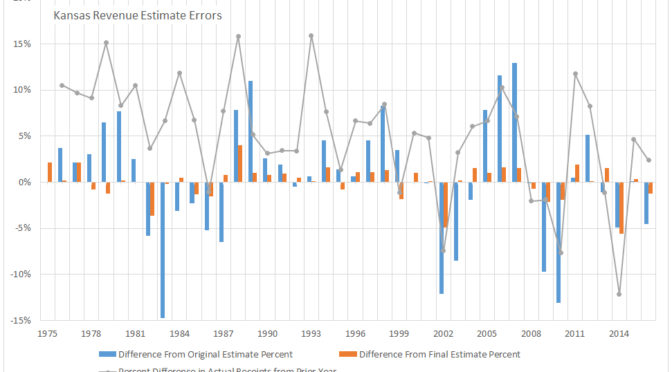Here’s a report on the special session of the Kansas Legislature from Karl Peterjohn, Executive Director of the Kansas Taxpayers Network. Thanks to Karl for his fine reporting and commentary.
Here’s the start of a blog for KTN and any other quality Kansas sites interested in this state’s fiscal crisis thanks to our left-wing, prejudiced Kansas supreme court. For the details on the court’s conflicts of interest see the recent KTN editorial column discussing Justice Nuss and Justice Allegrucci’s need to recuse themselves in the school finance litigation.
The house is likely done for the day (June 22) with all eyes watching efforts to put together a bill that would raise state school spending beyond the $143 million sought by the court and try and turn Kansas into a state with franchise casinos dotting the state. Kansas would be the only state that I know of where the casinos would be “owned” by the state and then contracted out to operators.
In theory there is a one subject limitation on any bills but once the court threw the rule book out the window it seems like anything goes and this bill could have gambling, appropriations, and new plumbing for the judicial center (tongue-in-cheek on last item) combined into one fat piece of legislation.
What makes this special session unique is the remodeling of the statehouse has forced the Kansas senate into meeting in the third floor chambers that once upon a time belonged to the Kansas Supreme Court. I jokingly asked if black robes were being issued to each senator. It is standing room only inside the chamber with senate leaders seated like judges at the front of the room and the backbench senators seated at a table in front of their leaders.
This is quite a change from the usual senatorial operations at the statehouse. It does seem appropriate in an era of judicial edicts setting and perhaps even determining the legislative outcome. First we have a bunch of black robed judges behaving like legislators. Now we have the Kansas senate meeting in the Old Supreme Court Chamber.
There seems to be a determination on the part of the liberal senators in both parties that a spending package of expanded gaming and reduced cash balances will allow them to expand spending according to the order from the court. Some senators want to expand the spending well beyond the court’s edict. I guess that will show them that they are not subservient to their judicial masters!
House members as a whole are not nearly as submissive as the senate. However, it is not clear what will be offered in the way of constitutional amendments to stick it to the court and defend the legislature’s constitutional and historic powers. The problem is that any amendment needs 27 senate votes and 84 house votes to be sent to the voters. that is a very difficult threshold to cross. There are hallway discussions on statutory provisions that would make it more difficult for the court to continue to meddle in legislative matters. Sadly, all too many legislators appear ready willing and able to submit to whatever nonsense the court ordered June 3 and could order in the future.
The school spending lobby held a rally this morning but the statehouse was ready for an anti-judicial tyrrany rally over the lunch hour. Elsewhere in the statehouse it looked like it was spend and fritter the taxpayers money away as usual. More details in an upcoming post.
Nationally, the Wall Street Journal editorial page has an editorial today entitled, “Jayhawk Judgment,” and sub-titled, “A constitutional showdown oer the power to tax.” It is excellent and I recommend it highly. Here are a couple of fair use quotes from it: “…under the Constitution’s separation of powers doctrine, the legislative branch makes the laws and the judicial branch interprets them. No so in Kansas these days. There the state Supreme Court has commanded that the legislature must increase spending on the schools, as well as the taxes to pay for it, by precisely $853 million over the next two years.” Later it says, “The legislature is sworn to abide by the Kansas Constitution, but that doesn’t mean abandoning its own powers of the purse to an unelected judiciary. This is a showdown between the branches of government, and the legislature has every right to protect its own constitutional prerogatives from judicial intrusion. In this case that means protecting Kansans from judicially ordered, and thus unconstitutional, tax increase.”
This is a national warning that any business looking to locate or expand in Kansas with our runaway courts and unlimited tax and spend policies would be crazy. Our neighbors will benefit from our spendthrift legacy. In fact there is vivid evidence of this legacy.
It is interesting to note that an important and largely unknown former Kansan died yesterday. The inventor of the integrated circuit chip Jack Kilby, originally from Great Bend, died at 81. This 2000 Nobel Laureate is an excellent example of a former Kansan who grew up here and moved elsewhere, like to Texas as in Texas Instruments to pursue his career. We graduate a lot of Jack Kilby’s from Kansas who return as regular “Kansas tourists” visiting family and friends over a week in summer or during the holiday season at Thanksgiving and Christmas. This is part of the price Kansas pays for being a high tax and big government state that regularly stifles entrepreneurship with the highest business property taxes and high corporate income taxes that were strongly criticized by Scott Hodges, the head of the Tax Foundation, at a Topeka forum June 14. Our property, income, sales, and excise taxes are lousy too. See other parts of KTN’s web site: www.kansastaxpayers.com for details.





